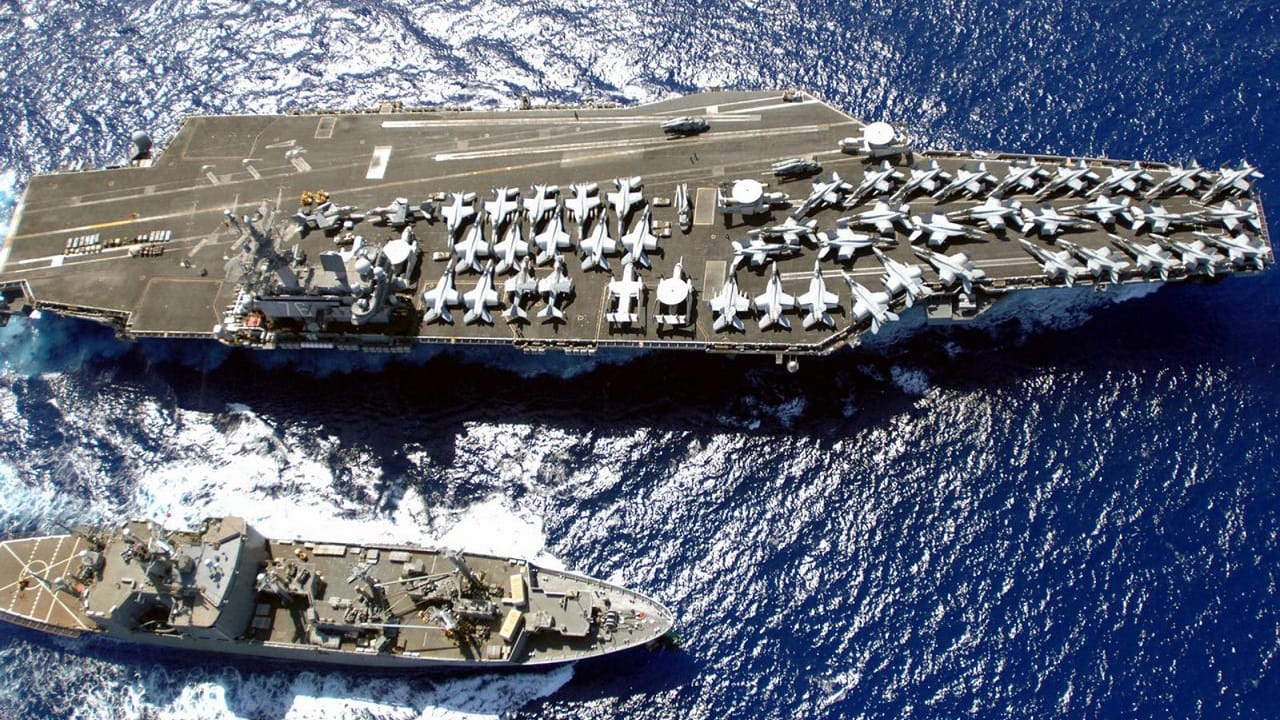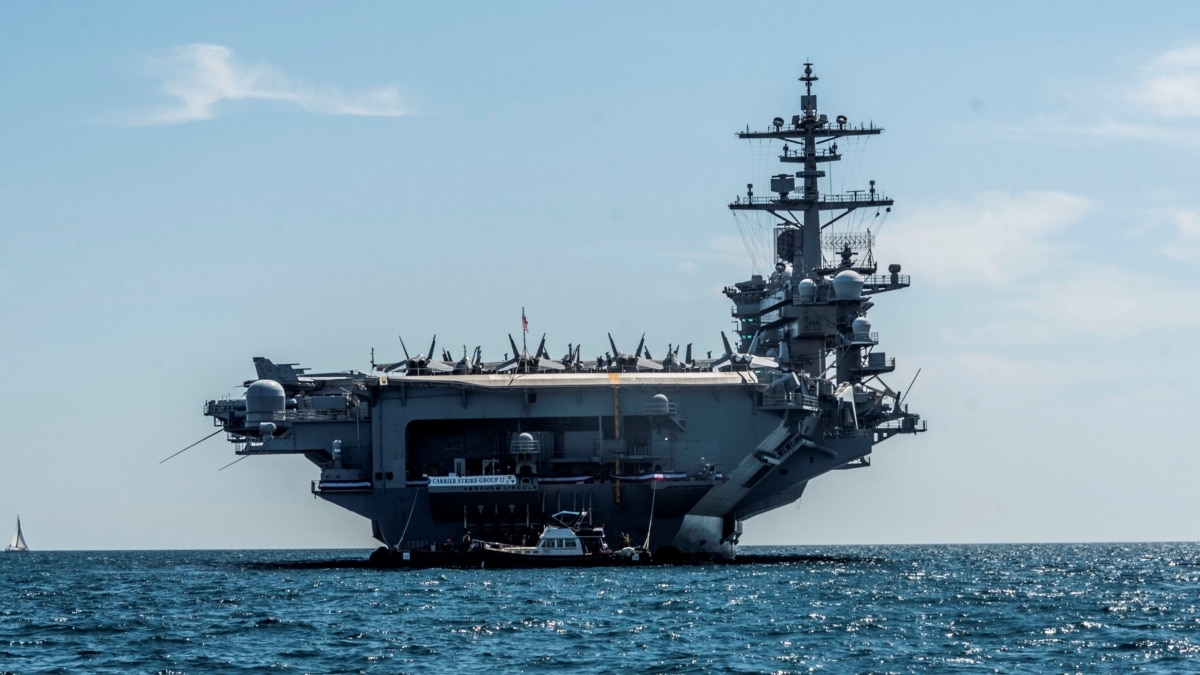Ramped Aircraft Carrier - A Royal Navy Sea Harrier taking off from a ski jump on the deck of HMS Invincible in May 1990.
In aviation, a ski jump is an upwardly curved ramp that allows aircraft to take off from a runway that is shorter than the aircraft's required takeoff run. By forcing the aircraft to climb, takeoff can be achieved at a lower airspeed than required for sustained flight, while allowing the aircraft to accelerate to that speed in the air rather than on the runway. Ski jumping is commonly used to launch aircraft from aircraft carriers without catapults.
Ramped Aircraft Carrier

The first use of a ski jump is believed to have occurred during World War II, when a temporary ramp was added to HMS Furious to assist the removal of the Fairey Barracudas, a heavy boy, on a strike mission against the German battleship Tirpitz .. During the Cold War, the concept was studied as a way of reducing the length of flight decks required for future aircraft carriers, as well as facilitating increasingly heavy aircraft at sea . The Royal Navy took a particular interest in ski jumping in the 1970s, conducting a series of tests with the newly developed Hawker Siddeley Harrier VSTOL fighter, before choosing to incorporate the feature into its next generation of aircraft carriers, the Invincible class. .
The Navy's Ultimate Dream Weapon: Merging An Aircraft Carrier And A Battleship
Having proven its operational value, many naval services have adopted ski jumping for their own aircraft carriers and amphibious assault platforms, while land use has also been explored. Ski jumping can be used in two different approaches, it is short takeoff but stalled recovery (STOBAR) and short takeoff and vertical landing (STOVL) aircraft; they belong to the operation of conventional and VSTOL aircraft respectively. Catapult-equipped aircraft carriers have become a minority in the 21st century due to the decreased cost and complexity of ski jumping operations.
The small Spanish-built Thai aircraft carrier HTMS Chakri Naruebet with a ski jump platform in the South China Sea in April 2001.
A fixed-wing aircraft must develop forward speed on a long takeoff run. As forward speed increases, the wings produce greater amounts of lift. At high speed, the lift force will exceed the weight of the aircraft, and the aircraft will be able to continue flying. Since the aircraft must reach cruising speed using only its own engines as a power source, a long runway is required for the aircraft to accelerate. On an aircraft carrier, the flight deck is so short that most aircraft do not reach cruising speed before reaching deck d. Since lift is less than gravity, the aircraft will lose altitude after the wheels leave the flight deck and possibly fall into the sea.
A ski jump ramp on the d of the flight deck redirects the aircraft at a slight upward angle, making part of the forward motion of the aircraft a positive rate of climb. Because the aircraft continues to travel at an insufficient speed to generate sufficient lift, its rate of climb begins to slow as soon as it leaves the flight deck. However, the ski jump launch gave the aircraft additional time to continue accelerating.
China Launches Third Aircraft Carrier: State Media
By the time its upward velocity has decayed to zero, the plane will be fast enough for its wings to produce enough lift. At this point, the aircraft is in stable flight, having taken off from the carrier at least below flight deck height.
Many modern aircraft carriers do not have catapults, so heavy aircraft must fly with their own engines. Ski jumping allows heavier aircraft to fly than a horizontal platform. However, ski jumping launches cannot match the payloads allowed by high-velocity slingshot launches.
Although aircraft such as the F/A 18, which are typically catapulted, can use a ski ramp, this is usually at the cost of a reduced capacity for fuel or ammunition and therefore has a negative impact. significant negative in mission scope.

A Fairey Barracuda departs from the temporary ski jump on HMS Furious in 1944. The wooden support structure of the ski jump is clearly visible.
Us Moves Carrier From Gulf In A Sign Of Ebbing Tensions With Iran
Early aircraft carriers could launch an aircraft simply by turning into the wind and increasing the speed of the ship to the speed experienced by the aircraft. During World War II, aircraft became so heavy that assisted takeoff became desirable. Deck catapults are used to accelerate aircraft to takeoff speed, especially when launching heavy aircraft or when changing course is inconvenient.
One of the earliest uses of the ski jump occurred in 1944, when the British aircraft carrier HMS Furious launched an attack on the German battleship Tirpitz. A rather crude ski-jump ramp was temporarily installed on the d of the flight deck, which assisted the bomb-loading Fairey Barracudas.
In the years following World War II, the prevailing trend of heavier aircraft continued apace, raising fears that such increases would eventually exceed the viable payload capacities of any airborne system. Because of this, an investigation into alternative methods to aid in removal was undertaken. A NACA study completed in 1952 suggested using a ski jump after the aircraft catapult to provide additional assistance to the departing aircraft.
In his 1973 M.Phil. thesis, Lt. Cdr. Dr. Taylor of Britain's Royal Navy proposed using a ski jump to assist the takeoff of the Harrier jump plane.
Japan, U.s. Conduct Joint Drill Involving Aircraft Carrier
His ski jump design, which featured a curve, was initially met with skepticism, but other officials endorsed the proposal's trial.
Therefore, initial testing with different ramp angles was performed at RAE Bedford; the aircraft used was the two-seat Harrier G-VTOL demonstrator.
These tests showed that performance increased with the ski jump angle, but the planners chose to choose the lowest angle, perhaps the reasoning behind this choice was to avoid putting too much stress on the vehicle's landing gear air

In the 1970s, the Royal Navy considered building a deck cruiser or light aircraft carrier and decided to include ski jumping in the project.
We're Watching You': Us Navy Sends Warning To Giant Chinese Aircraft Carrier
Because of this, Invincible-class carriers were built with ski jumps, greatly shortening the distance required for Harriers to fly with a payload.
The ski jump proved to be a relatively inexpensive and simple addition to the carriers, consisting of steel construction with no moving parts. A ski jump was added to the first such carrier, HMS Invincible, while laid up at Barrow; is set at a conservative angle of 7º. On 30 October 1980, test pilot Lt Cdr David Poole performed the first ski-jump-assisted sea takeoff of a Harrier.
HMS Illustrious was also the first to be fitted with a 7th ramp; however, HMS Ark Royal was built with a 12º ramp from the start, having already determined the optimum angle. The previous two ships were equipped with 12º ramps to improve the performance of their aircraft.
After the success of the Harrier, ski jumping became a proven method of launching aircraft from ships without the complexity and expense of a catapult. Additionally, later ski jumping models feature refinements to the original design; relatively small grooves or blemishes on a perfectly smooth surface have been determined to be sufficient to induce cracking in the aircraft's landing gear. This is why the Royal Navy implemented tighter design tolerances on the ramp specifications of the Que Elizabeth-class aircraft carrier.
How Russia's Lone Aircraft Carrier Will Change The Fight In Syria
A modern ski jump can be built as a single removable structure placed above the forward flight deck, rather than fully integrated into the ship's bow.
Ski jumps were added not only to aircraft carriers, but also to many amphibious assault ships and helicopter landing docks to facilitate the operation of STOVL aircraft.
Australian and Spanish Juan Carlos class helicopter landing docks (LHDs) are also equipped with ski jumps to facilitate potential STOVL operations. Somewhat unusually, the US Navy has never used ski ramps aboard its amphibious assault ships, although they are widely used by VSTOL aircraft, such as many models of Harrier jump jets and the Lockheed Martin F -35B Lightning II; it was asserted that this was due to their operations involving the combined use of helicopters and boats.

At the beginning of the 21st century, the British, Chinese, Indian, Italian, Russian, Spanish and Thai navies all possessed aircraft carriers equipped with ski ramps.
China To Show Off New Nuclear Subs, Destroyers For First Time At Fleet Review Marking Navy's 70th Anniversary
Following the retirement of the Brazilian aircraft carrier São Paulo in 2017, the United States and France are the only two countries still operating aircraft carriers with catapults.
In Short Take-Off But Arrested Recovery (STOBAR) aircraft carriers, conventional aircraft are launched using a ski jump. The pilot increases the thrust of the aircraft by igniting the afterburners, while holding the aircraft down. Two panels rise from the carrier deck in front of the aircraft's main landing gear, ensuring that the aircraft remains stationary. On command, the pilot released the brakes; the deck panels return to their slots; and the aircraft rapidly rolls forward with maximum thrust. Rolling over the ski ramp launches the plane up and forward.
A MiG-29 launched over a ski jump ramp on a Kuznetsov-class aircraft carrier can fly at a speed of about 70 knots (130 km/h; 81 mph), instead of the usual 140 knots (260 km/h). h; 160 mph) (depending on many factors, such as gross weight).
Except
Us Says Carrier Group In South China Sea
Aircraft appraisal online, free aircraft appraisal, aircraft appraisal services, aircraft appraisal cost, aircraft appraisal jobs, aircraft appraisal course, aircraft appraisal training, business appraisal, rolex appraisal, appraisal software, 409a appraisal, aircraft appraisal report
Post A Comment:
0 comments so far,add yours